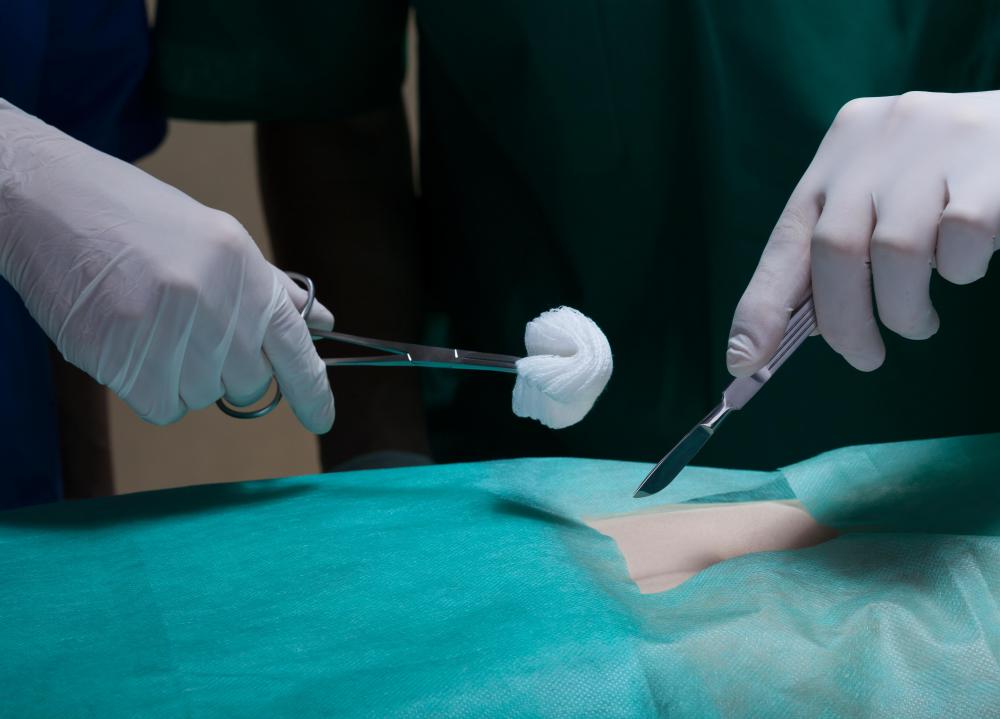At TheHealthBoard, we're committed to delivering accurate, trustworthy information. Our expert-authored content is rigorously fact-checked and sourced from credible authorities. Discover how we uphold the highest standards in providing you with reliable knowledge.
What Is Involved in Cherry Angioma Removal?
Cryotherapy, electrosurgery, and laser vaporization are some of the relatively painless procedures that licensed dermatologists use for cherry angioma removal. The technique used may vary from physician to physician and depends on the size and thickness of the lesion. Individuals typically undergo procedures on an outpatient basis. Following the removal of the cherry angioma, clinics usually provide patients with aftercare instructions and information concerning possible adverse conditions. Cherry angiomas usually present no danger, but elevated lesions may tear or bleed, causing the desire for removal.
Cherry angioma removal using cryotherapy entails destroying tissue by freezing the fluid in and between cells, causing expansion from ice formation and subsequent rupture and cell death. Dermatologists generally apply argon gas or liquid nitrogen to the site using a swab or pen like instrument that emits the chemical. Topical treatments usually do not require any anesthesia. Following treatment, the affected area peels, blisters or scabs depending on the amount of the freezing agent applied. The dead tissue sloughs off naturally and physicians might suggest applying antibiotic ointment or petroleum jelly to the area.

Electrosurgical angioma treatment destroys tissue by using low frequency electrical current. A power generator supplies the current, which flows into a wire loop, needle, or wire. As the tip of the applicator remains cool to the touch, patients may or may not require local anesthetic. The energy produced by the appliance passes into tissue and disrupts the molecular structures by destroying proteins. The applicator simultaneously destroys cells, inhibits bleeding, and cuts through tissue by causing cellular rupture.

The skill of the physician and the advanced technological features of the instrumentation allow cherry angioma removal without harming healthy surrounding tissue. The depth and diameter of the surgical wound determines whether sutures are needed. Sites not closed by suture generally require daily cleansing followed by antibiotic ointment or petroleum jelly application. Physicians might also suggest protecting the site with an adhesive bandage.

Prior to angioma removal by laser vaporization, patients must not expose skin to the sun, as tanned skin resists the effects of treatment. This method of cherry angioma removal also usually does not require local anesthesia as the applicator wand emits a cold spray before transmitting the laser pulse. Cells generally convert the pinpoint bursts of yellow light into heat energy, which immediately kills cells. Slight bruising may occur at the treatment site up to three days following the procedure. Crusty scab formation, which naturally subsides along with any bruising, may occur as well.
AS FEATURED ON:
AS FEATURED ON:
















Discussion Comments
Is it possible to remove cherry angiomas at home?
The pharmacy has a few products for removing warts and I found a product online that can be used for moles. Should I try these?
I don't want to go to a dermatologist and pay for removal because I have many cherry angiomas all over my body. If I can remove them myself safely, I'd rather do that.
Does anyone know of a sure and safe home removal method?
@fify-- I think that laser and electrolysis treatments are least likely to cause scarring. Laser dries out the angioma with the use of light. Electrolysis does the same thing but through electrical impulses. The only downsides to these treatments are that more than one session may be required and it may cost more.
Most people have their cherry angiomas removed with cryotherapy. It's cheaper but unfortunately there is a risk of scarring. Plus, sometimes liquid nitrogen requires more than one session as well.
What is the best way to remove cherry angiomas? I know that most of these methods do not cause pain but what about scarring? Which method is least likely to cause scarring?
I had a cherry angioma removed ten years ago with electrosurgery and it left a scar, so I don't want to do that again.
Post your comments